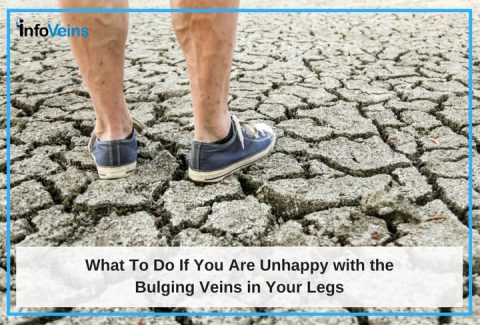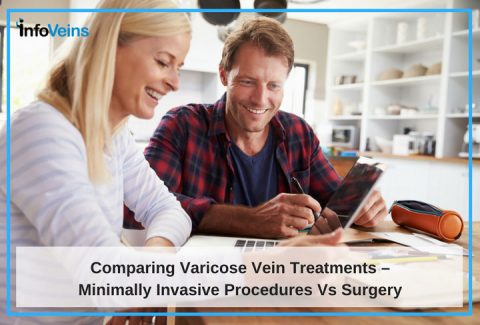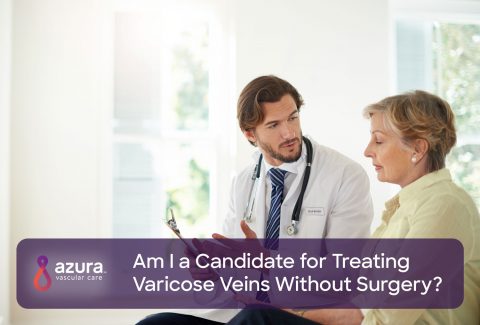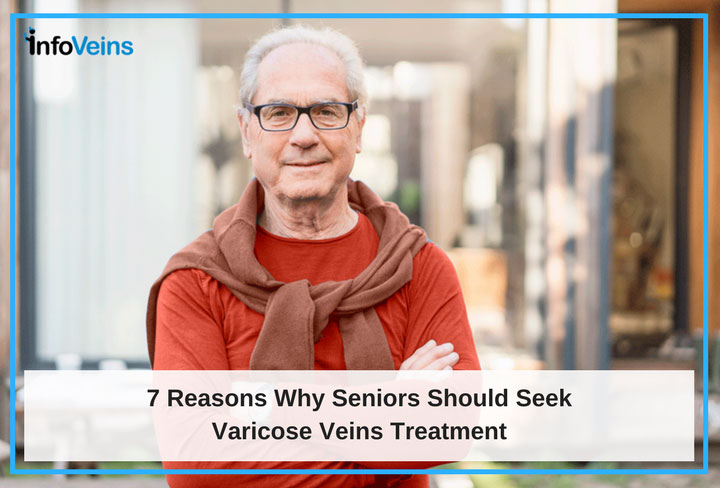
Varicose veins are more common as we age. Why? The answer is actually pretty simple. As we get older, those one-way valves in our veins that keep blood from flowing backward get weaker, allowing for the blood to flow backwards. The pressure from the increased amount of blood within the vein build ups, resulting in twisted, bulging veins known as varicose veins.i If you’re a senior with varicose veins, you are not alone. At least 16% of adults with varicose veins are over the age of 60.ii
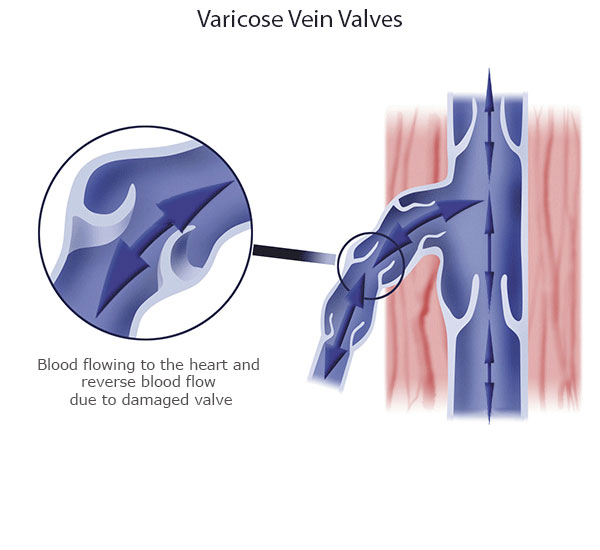
Have you been thinking about treating your varicose veins? Are you struggling with the decision because you think they’re just a cosmetic problem? Would you be surprised to find out that there are actually other important, health-related reasons to treat your varicose veins?
Read on for our top 7 reasons why you may want to consider varicose veins treatment sooner than later.
7 Reasons Every Senior Should Think About Varicose Veins Treatment
#1. Discomfort
At least 65% of adults over the age of 60 diagnosed with varicose veins have reported at least one leg symptom related to their varicose veins.iii Whether you have burning, throbbing, heaviness or pain in your legs, treatment may be able to help you live a more comfortable life.
#2. Swelling
As blood pools, fluid can leak out of the vein and into the surrounding tissue just beneath the skin, sometimes causing substantial swelling. Compression stockings might help this, but as the varicose veins get worse, the swelling can get worse, too.iii Is it difficult to get out of your house because your legs are so swollen? Talking to your doctor may help you figure out a treatment plan to improve your leg swelling.
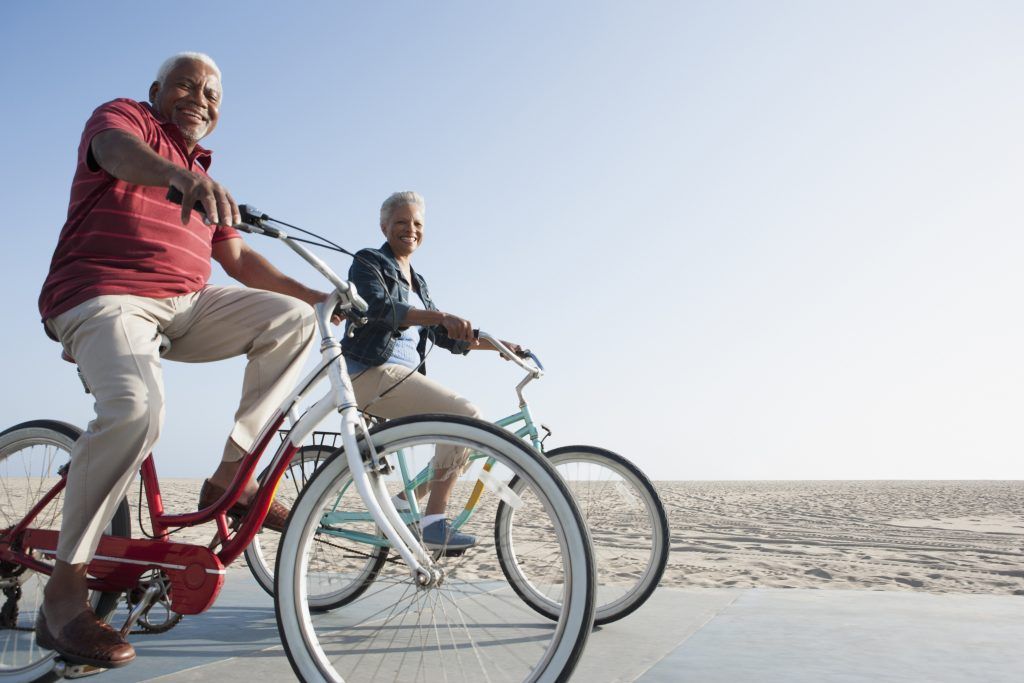
#3. Limiting Physical Activity
Has your desire or ability to exercise regularly or perform physical activities such as running, tennis, cycling due to the discomfort and pain from varicose veins? Speaking to your doctor about varicose veins treatment options can help get you back to your desired routine.
#4. Bleeding
Varicose veins are close to the skin surface and full of blood. Even small cuts can lead to bleeding that is hard to stop. Treating these veins can often improve this problem.iv
#5. Blood clots
Slower blood flow increases the chance that a blood clot will form, so improving blood flow may decrease your risk of developing a blood clot. If you’re being treated for a blood clot, your doctor will likely tell you that you need to wait to treat your varicose veins until the blood clot is gone.iv
#6. Leg ulcers
Leg ulcers are sores on the legs that heal slowly or do not heal at all. Swelling and other changes in the skin make it harder for the body to heal from even small injuries. Treating your varicose veins could possibly help prevent leg ulcers.v
#7. Skin infections
In addition to problems with sores that don’t heal, the swelling caused by varicose veins increases your chance of getting a skin infection known as cellulitis.v If you have a red, swollen and painful vein or part of your leg, you should see a doctor right away to determine what is wrong and discuss treatment options. Treating your varicose veins may decrease the swelling and reduce your risk of getting an infection.
Varicose Veins Treatment Options
If you’ve already tried some of the completely non-invasive treatment options such as elevating your legs, losing weight, wearing compression stockings and exercising regularly, and you still have problems, it’s probably time to find a specialist, such as an Interventional Radiologist or Vascular Surgeon. The most common treatment options for varicose veins are surgery or minimally invasive alternatives to surgery.
RELATED: 6 Hidden Dangers if You Don’t Treat Varicose Veins
Varicose Vein Surgery
Varicose vein surgery was the original treatment and, for many years, the only choice for treatment that varicose vein sufferers had available to them. Through an incision in the groin, the varicose veins are tied off, or ligated, and some of the superficial veins are then pulled, or stripped, out of the skin. The recovery from surgery typically takes more time, has more complications and is more painful than other, less invasive options.iv
Minimally Invasive Options
Minimally invasive treatments were developed to provide relief from varicose veins without the lengthy, complicated and painful recovery that comes with ligation and vein stripping. These non-surgical treatments are performed by Interventional Radiologists and Vascular Surgeons who are trained in the use of x-rays and ultrasound to visualize and treat varicose veins without the need for.iv
 Endovenous ablation – Heat, either from a laser or radiofrequency waves, is used to scar the inside of the varicose vein.
Endovenous ablation – Heat, either from a laser or radiofrequency waves, is used to scar the inside of the varicose vein.- Microphlebectomy – Small cuts are made in the skin to remove the varicose veins. This is also called ambulatory phlebectomy and is often used along with endovenous ablation.
- Sclerotherapy – The inside of the vein is scarred with a solution that is injected into the vein through a small needle. The scaring causes blood flow to reroute to healthier veins. This procedure typically works well on spider veins, which are small cosmetic varicose veins, and small varicose veins.
Do you have reasons to treat your varicose veins? If you do, and you want to avoid surgery, find an Interventional Radiologist or Vascular Surgeon in your area who specializes in varicose veins treatment and set up a consultation to review your options.
Sources:
i Mayo Clinic. Varicose Veins Overview. http://www.mayoclinic.org/diseases-conditions/varicose-veins/home/ovc-20178078 (updated 1/22/2016, accessed 11/30/2016)
ii Joseph, N., B, A., Faizan Thouseef, M., Devi, M.U., Abna, A., Juneja, I., A multicenter review of epidemiology and management of varicose veins for national guidance. Ann Med Surg (Lond), 2016. 8: p. 21-7. https://www.ncbi.nlm.nih.gov/pmc/articles/PMC4878844/
iii Wrona, M., Jockel, K., Pannier, F., Bock, E., Hoffmann, B., Rabe, E., Association of Venous Disorders with Leg symptoms: Results from the Bonn Vein Study 1. Eur J Vasc Endovasc Surg, 2015. 50: p. 260-267. http://www.ejves.com/article/S1078-5884(15)00333-0/pdf
iv Lin, F., Zhang, S., Sun, Y., Ren, S., Liu, P., The Management of Varicose Veins. Int Surg, 2015. 100: p. 185-189. https://www.ncbi.nlm.nih.gov/pmc/articles/PMC4301287/
v Pugliese, D., Infection in Venous Leg Ulcers: Considerations for Optimal Management in the Elderly. Drugs Aging, 2016. 33(2): p. 87-96. https://www.ncbi.nlm.nih.gov/pubmed/26833351

